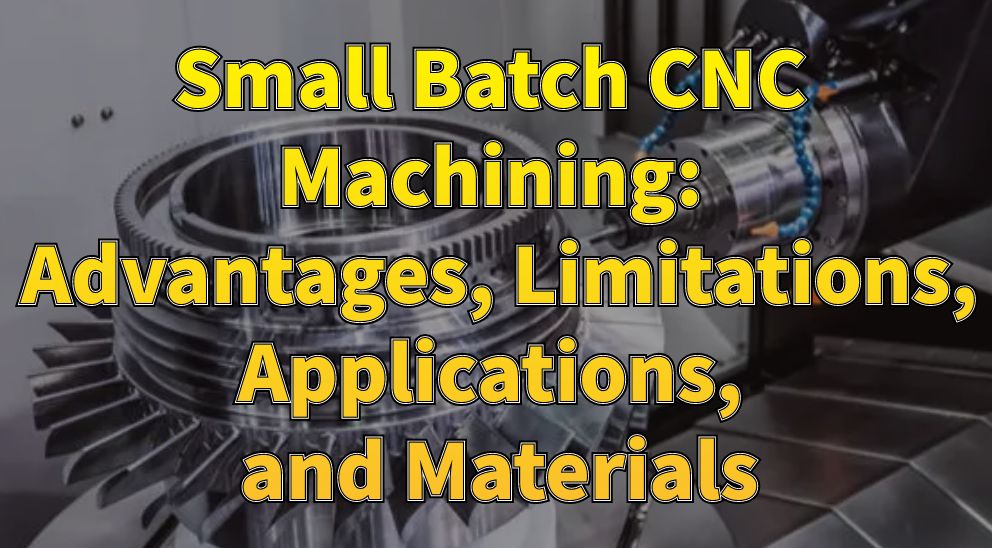CNC machining has revolutionized the way we manufacture complex parts and components. With the help of computer-controlled machine tools, we can produce parts with high precision and consistency, saving time and reducing costs. However, not all machining projects require mass production. For small batches of parts, CNC machining still holds some distinct advantages. In this article, we will explore the benefits and limitations of small batch CNC machining, as well as its applications and the materials that it can process.

Advantages of Small Batch CNC Machining:
Cost-effectiveness: One of the most significant advantages of small batch CNC machining is that it can be more cost-effective than other manufacturing methods, such as injection molding or die casting.
Small batch production can reduce tooling costs and eliminate the need for expensive molds.
Flexibility: Small batch CNC machining is more flexible than mass production. Since the machines can quickly switch between different parts, small batch production is ideal for prototype development, customized parts, and short-run production.
Faster turnaround times: Small batch CNC machining can often produce parts faster than other methods. Since there is no need for mold production or other specialized tooling, the turnaround time for small batch production can be much quicker.
High precision: CNC machines can produce parts with high accuracy and consistency. Small batch production can benefit from this high precision, as even small variations in part dimensions can be critical in industries such as aerospace and medical device manufacturing.
Limitations of Small Batch CNC Machining:
Setup time: Even though small batch CNC machining can be more cost-effective, the setup time for each job can be significant. The machines require a lot of preparation to ensure they are set up correctly, and the programming time can also add to the setup time.
Part size limitations: Small batch CNC machining has size limitations. The machines have a limited range of motion, which can limit the size of the parts they can produce. Additionally, the size of the machine itself can also limit the size of the parts it can accommodate.
Material limitations: CNC machines can only work with certain materials. Some materials, such as ceramics or glass, are difficult to machine with CNC equipment. Additionally, some materials may require specialized tooling or processes, which can add to the setup time and cost.
Applications of Small Batch CNC Machining:
Aerospace: Small batch CNC machining is often used in the aerospace industry to produce small batches of complex parts. The industry requires high precision and consistency, making CNC machining an ideal solution.
Medical device manufacturing: Small batch CNC machining is ideal for producing customized parts for medical devices. CNC machines can produce parts with high precision, which is essential for the medical industry.
Automotive: The automotive industry often uses small batch CNC machining to produce specialized parts or customized components. CNC machining can produce parts with high precision and consistency, making it an ideal solution for the industry.
Materials for Small Batch CNC Machining:
Metals: CNC machines can work with a variety of metals, including aluminum, steel, and titanium. These materials are commonly used in aerospace and automotive industries.
Plastics: CNC machines can work with a range of plastics, including ABS, polycarbonate, and PVC. These materials are commonly used in consumer products and medical device manufacturing.
Composites: CNC machines can work with composites, such as carbon fiber, which are commonly used in aerospace and automotive industries.
Conclusion:
Small batch CNC machining has several advantages, including cost-effectiveness, flexibility, faster turnaround times, and high precision. However, there are also some limitations, such as setup time and material and size limitations. Small batch CNC machining is ideal for industries such as aerospace, medical device
Small batch CNC machining is ideal for industries such as aerospace, medical device manufacturing, and automotive, where precision and consistency are critical. Additionally, small batch production is suitable for customized parts, prototype development, and short-run production.
In terms of materials, CNC machines can work with various metals, plastics, and composites. Metals such as aluminum, steel, and titanium are commonly used in aerospace and automotive industries. Plastics such as ABS, polycarbonate, and PVC are frequently used in consumer products and medical device manufacturing. Composites, such as carbon fiber, are also commonly used in aerospace and automotive industries.
In conclusion, small batch CNC machining has its advantages and limitations. However, for industries that require high precision and consistency, small batch production can be a cost-effective and flexible solution. With the ability to work with various materials and produce complex parts, CNC machining continues to revolutionize the way we manufacture components and parts.
About JTC CNC Machining
JTC Model Technologies Co., Ltd., established in 2008 by Wenbing Huang who has been in the machining processing for over 20 years, to provide prototype making service. After many years of efforts, the company has built a high & reliable reputation within the prototypes making community and among customers. Under the direction of Mr. Huang, the company has expanded, besides rapid prototyping, it's business scope also involves CNC machining, Die casting, Injection molding and other one-stop services. In 2012, Mr. Huang decided to open a foreign sales department to develop more business. During the past ten years, we have provided various of metal components to the customers all over the world.

